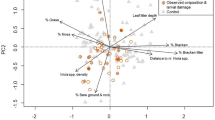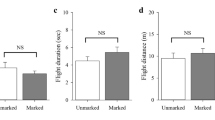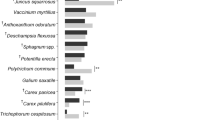Abstract
The habitat of Luehdorfia puziloi inexpecta was analyzed by using Quantification Theory Type I, a method for quantifying qualitative data. The investigation area was divided into 92 small sections and was surveyed for its environmental characteristics such as type of trees, tree trunk girth, condition of undergrowth, geography, aspect of slope, and amount of food plants. Environmental factors suitable for oviposition were analyzed using the area density of eggs in each section as the external criterion. The results showed the order of importance of environmental factors to be: aspect of slope > amount of food plants > tree type = tree trunk girth > condition of undergrowth > geography. A slope facing northeast, rich in food plants, with deciduous trees of trunk girth larger than 40 cm, with undergrowth below 30 cm and along a ridgeline was the most preferable habitat for the butterfly.
Similar content being viewed by others
References
Collins N.M. and Morris M.G. 1985. Threatened swallowtail butterflies of the world (The IUCN Red Data Book). IUCN, Gland Switzerland and Cambridge UK, 401 pp.
EAJ, 1991. Threatened wild life in Japan (Invertebrate Red Data Book). The Environmental Agency of Japan, Tokyo Japan, 106 pp (in Japanese).
Fukuda H., Hama E., Kuzuya T., Takahashi A., Tanaka B., Tanaka H., Wakabayashi M. and Watanabe Y. 1982. The Life Histories of Butterflies in Japan, vol. I, Hoikusya Publishing, Osaka Japan, pp. 80-83 (in Japanese).
Gunma prefecture, 2002. Endangered Wildlife in Gunma (Red Data Book in Gunma). Gunma prefecture, Gunma Japan, 127 pp (in Japanese).
Hayashi C., Shibata Y., Higichi S., Toyoshima J., Hayashi F. and Maruyama N. 1997. 'Shinrin Yasei Doubutsu No Chosa' (Investigation of statistic methods of estimating the size of an animal population and Environmental Analysis). Kyoritsu Shuppan, Tokyo Japan (in Japanese).
Komazawa T., Hashiguchi K. and Ishizaki R. 1998. Quantification Theory Type I. In: Akaike H. (ed.), ''Pasokon Suryoka Bunseki'' (Quantification method for PC), Asakura Syoten, Tokyo Japan, pp. 5-45 (in Japanese).
Matsumoto K., Ito F. and Tsubaki Y. 1993. Egg cluster size variation in relation to the larval food abundance in Luehdorfia puziloi (Lepidoptera: Papilionidae). Res. Popul. Ecol. 35: 325-333.
Matsumura T. 1996. Conservation of Luehdorfia puziloi at Mt. Akagi. In: Ae S., Hirowatari T., Ishii M. and Brower L.P. (eds), Decline and Conservation of Butterflies in Japan III (Yadoriga spec. Issue), The Lepidopterological Sciety of Japan, Osaka, Japan, pp. 168-171.
Matsumura T. 1997. Effect of temperature on the population size change of Luehdorfia puziloi inexpecta Sheljuzhko (Lepidoptera, Papilionidae). Trans. Lepid. Soc. Japan. 48: 109-114 (in Japanese).
Matsumura T. 2000. Behavior of Luehdorfia puziloi inexpecta Sheljuzhko (Lepidoptera, Papilionidae) and environmental manipulation for oviposition in Mt. Akagi. Field Biologist. 10: 1-6 (in Japanese).
Matsumura T. 2001. Conservation of the declining Luehdorfia puziloi inexpecta Sheljuzhko (Lepidoptera, Papilionidae) at Mt. Akagi in Gunma Prefecture, Japan. Trans. Lepid. Soc. Japan. 52: 91-100.
Matsumura T. 2002. Yearly change of Luehdorfia puziloi inexpecta Sheljuzhko (Lepidoptera, Papilionidae) at Mt. Akagi in Gunma Prefecture, Japan. Trans. Lepid. Soc. Japan. 53: 45-54 (in Japanese).
New T.R. and Collins N.M. 1991. Swallowtail Butterflies (An Action Plan for their Conservation). IUCN, Gland Switzerland, 36 pp.
Shibata Y., Hayashi T., Fujioka H., Higuchi S. and Kadosaki Y. 1993. An Environmental analysis for activity of hare in summer at the foot of Mt. Akita-koma. J. Japanese Wildlife Res. Soc. 19: 11-17 (in Japanese).
Sugawara T. 1996. Genus Asarum. In: Watanabe Y. (ed.), Monograph of Luehdorfia Butterflies, Hokkaido University Press, Sapporo Japan, pp. 172-181 (in Japanese).
Tsubaki Y. 1995. Clutch size adjustment by Luehdorfia japonica. In: Scriber J.M., Thubaki Y. and Lederhouse R. (eds), The Swallowtail Butterflies (Their Ecology and Evolutionary Biology), Scientific Publishers, Gainsville USA, pp. 63-70.
Watanabe Y. 1996. Ecology by region. In: Watanabe Y. (ed.), Monograph of Luehdorfia Butterflies, Hokkaido University Press, Sapporo Japan, pp. 207-226 (in Japanese).
Yokohama City, 1982. Investigation Report for Animals at Enkai-san Area. Report for Basic Research Relevant to Conservation and Use of Special Conservation Area of Enkai-san Suburban Green Area (in Japanese).
Author information
Authors and Affiliations
Rights and permissions
About this article
Cite this article
Matsumura, T. Analysis of ovipositional environment using Quantification Theory Type I: the case of the butterfly, Luehdorfia puziloi inexpecta (Papilionidae). Journal of Insect Conservation 8, 59–67 (2004). https://doi.org/10.1023/B:JICO.0000027509.99459.b5
Issue Date:
DOI: https://doi.org/10.1023/B:JICO.0000027509.99459.b5




